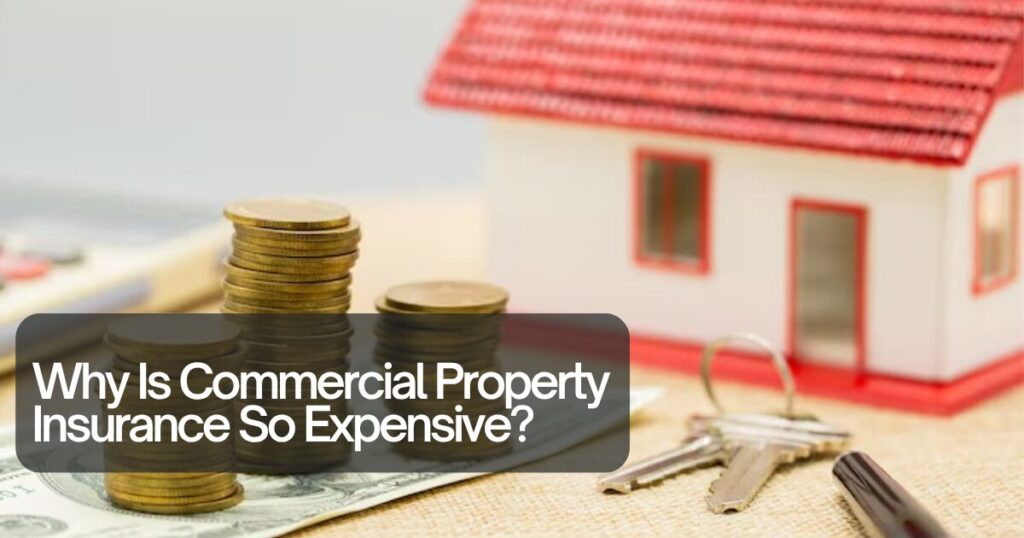
Commercial property insurance protects business buildings, equipment, inventory, furniture, and technology from fire, theft, vandalism, lightning, wind, and explosions. Small businesses pay an average of $67 monthly or $800 annually, though costs vary by location, industry, building age, and coverage limits. Standard policies exclude floods, earthquakes, employee theft, normal wear and tear, and commercial vehicles—requiring separate coverage for these risks.
Why Is Commercial Property Insurance So Expensive in 2025?
The phone call came at 3 AM. Your restaurant’s sprinkler system malfunctioned, flooding three dining rooms and the kitchen. Water destroyed $80,000 in equipment, ruined inventory worth $15,000, and forced you to close for two weeks of repairs. Without commercial property insurance, you’d be writing checks totaling over $120,000—money that could bankrupt a thriving small business overnight.
Forty percent of small businesses experience a property claim within 10 years, with fire, theft, and water damage leading the list. Natural disasters alone generate nearly $80 billion in insured losses annually, and 2024 continued the trend of increasing billion-dollar weather disasters. These mounting claims have pushed commercial property insurance premiums up by 20.4% in Q1 2023—the first time in two decades rates exceeded 20%.
This guide explains exactly what drives commercial property insurance costs in 2025, what your policy covers and excludes, and how to protect your business investment without overpaying.
What Commercial Property Insurance Actually Protects
Your business represents years of work, substantial investment, and your livelihood. Commercial property insurance creates a financial safety net when disaster strikes your physical assets.
The policy covers your building structure if you own the property—walls, roof, floors, completed additions, permanently installed fixtures like built-in shelving, and HVAC systems. For businesses leasing space, the landlord typically insures the building while you insure your improvements and contents. This includes business personal property like computers, furniture, machinery, tools, inventory, supplies, and equipment essential to operations. Even personal property of others temporarily in your care qualifies for coverage—customer equipment you’re repairing, consigned goods you’re selling, or client materials stored in your facility.
Coverage extends to specific perils depending on your policy type. Fire remains the most common and devastating business risk, with policies covering structure repair, equipment replacement, and inventory losses. Theft protection matters especially for retailers and businesses storing valuable inventory or equipment. Vandalism coverage addresses malicious damage from broken windows to spray-painted walls. Lightning damage includes fires and electrical surges that fry sensitive electronics—crucial protection given how dependent businesses are on technology.
Wind damage from hurricanes, tornadoes, and severe storms falls under most policies, though coastal businesses face special considerations. Explosions from gas leaks, chemical reactions, or equipment failures trigger coverage. Water damage from burst pipes, leaking roofs, or malfunctioning sprinkler systems qualifies—but here’s the critical distinction: water coming from inside your building is covered, while water entering from outside (floods) requires separate insurance.
Business interruption coverage, often bundled with property insurance, reimburses lost income when covered perils force temporary closures. If that restaurant flood shuts you down for three weeks, business interruption pays ongoing expenses like payroll, rent, and loan payments plus covers lost revenue during repairs. This financial lifeline keeps businesses solvent through recovery periods.
Understanding What’s Not Covered and Why
Standard commercial property insurance excludes specific risks that require specialized coverage. Understanding these gaps prevents devastating surprises when filing claims.
Flood damage sits at the top of exclusion lists. Water entering your building from external sources—overflowing rivers, storm surge, heavy rainfall, or sewer backups—isn’t covered. Flood insurance only covers removing water and cleanup in some cases, not replacing damaged drywall, furniture, or computers. Businesses in flood zones absolutely need separate flood insurance, but even companies outside designated zones benefit from this protection since construction activities and blocked storm drains can cause unexpected flooding.
Earthquake damage requires a separate policy or endorsement. Ground movement from earthquakes, sinkholes, mudslides, or land subsidence falls outside standard coverage. Businesses in California, the Pacific Northwest, and other seismically active regions face significant exposure without earthquake insurance. This specialized coverage protects buildings, equipment, and machinery plus compensates for lost business income during rebuilding.
Normal wear and tear never qualifies for coverage. Insurance companies expect property owners to maintain buildings and replace aging components through regular upkeep. That roof leaking after 25 years of weathering won’t trigger a claim. Carpets worn from foot traffic, paint fading from sunlight, and equipment breaking down from age all fall to you. Termite and insect damage, bird or rodent damage, rust, rot, and mold from poor maintenance similarly get excluded.
Commercial vehicles aren’t protected under property policies. Company cars, delivery vans, trucks, and specialized vehicles need commercial auto insurance regardless of their value to your business. Even if that $75,000 service van parks inside your building nightly, it requires separate coverage.
Employee theft doesn’t fall under standard commercial property insurance. When staff members steal inventory, equipment, or cash, you need employee dishonesty coverage or a fidelity bond. External theft by burglars qualifies for coverage, but internal theft from people you trust requires additional protection.
Equipment breakdown from mechanical failure or malfunction sits outside property coverage. When your HVAC system dies from worn parts, your industrial printer stops working, or your commercial oven quits heating, those repairs come from your pocket. Equipment breakdown insurance covers unexpected failures including emergency replacements—valuable protection for businesses dependent on specialized machinery.3
People Also Love to Read This: Best Class Action Lawsuit Attorney: 5 Steps to Find the Right One
Why Commercial Property Insurance Costs Keep Rising
Premium increases have accelerated dramatically, leaving business owners struggling to budget for essential coverage. Multiple converging factors drive these cost spikes.
Climate-related disasters continue intensifying. 2023’s global insured losses from natural disasters exceeded $100 billion for the fourth consecutive year, with the U.S. experiencing record billion-dollar weather events costing over $57 billion. Severe convective storms—thunderstorms, tornadoes, hailstorms—accounted for 68% of weather-related losses in the first half of 2023, totaling $35 billion in financial impact. Climate experts predict these patterns will amplify, further increasing commercial property losses and premiums.
Construction and repair costs have risen significantly through 2025. Labor shortages in the construction industry persist, and material costs remain elevated compared to pre-pandemic levels. Rebuilding a damaged warehouse that cost $500,000 in 2020 might require $650,000 today. Volatile building material prices make accurate property valuations crucial, yet recent industry research reveals significant inaccuracies in insurance-to-value calculations, with coverage gaps exceeding 30%.
Litigation trends toward increasingly large demands cost the industry money passed to policyholders. When businesses suffer catastrophic losses, lawsuits seeking maximum compensation have become standard. Defense costs and higher settlement amounts force insurers to raise premiums across their entire book of business.
Economic uncertainty and inflation compound these challenges. Insurance companies factor heightened financial risk into pricing models during unstable economic periods. Supply chain disruptions, rising interest rates, and volatile markets all contribute to premium calculations.
How Your Business Affects Commercial Property Insurance Rates
While market conditions drive overall trends, your specific business characteristics determine your actual premium. Understanding these factors helps you make strategic decisions to control costs.
Location plays a major role in determining property insurance costs. Businesses in areas known for extreme environmental events—wildfires, hurricanes, earthquakes, sinkholes—face much higher premiums due to increased damage risk. Colorado businesses enjoy some of the nation’s lowest rates at around $56 monthly, while Texas and Florida experience among the highest premiums due to hurricane exposure along the Gulf Coast and tornado risks in northern plains. Even micro-location matters—buildings tucked between larger structures with protection from elements, or properties near fire stations and police departments, typically earn lower premiums.
Industry type significantly impacts costs due to inherent operational risks. A butcher, baker, and candlestick maker all face different risks—the one working with open flames and flammable materials will probably pay the highest premium. Manufacturing companies with heavy machinery, chemical storage, and production lines pay substantially more than technology consultants working from home offices. Construction companies might pay double the average due to significant equipment and storage space risks.
Building age and construction materials influence pricing. Newer buildings constructed with fire-resistant materials like brick, concrete, or stone typically cost less to insure than flammable wooden structures. Charming old buildings with character also come with outdated electrical systems, aging plumbing, and roofs that have weathered decades of storms—factors that increase claim likelihood and premiums.
Coverage limits directly affect premiums. Building coverage typically ranges from $250,000 to $1 million, while business property coverage usually falls between $50,000 and $250,000. Higher limits provide better protection but increase costs proportionally. Many business owners haven’t increased insurance limits to keep pace with rising replacement costs, creating dangerous underinsurance that leaves them vulnerable to devastating losses.
Your claims history follows you. Businesses with multiple previous claims face higher premiums because insurers view them as higher risk. Conversely, years without claims can qualify you for lower rates through loss-free discounts.
Strategies to Reduce Commercial Property Insurance Costs
You can’t eliminate the need for coverage, but smart approaches help manage premiums without sacrificing protection.
Install safety systems to help protect against property damage. Smoke detectors, sprinkler systems, fire extinguishers, security cameras, commercial-grade locks, and alarm systems all demonstrate risk mitigation to insurers. Implementing a multicomponent security plan with multiple cameras and commercial locks helps prevent vandalism, especially in high-crime environments. These investments pay double dividends—they actually prevent losses while reducing premiums.
Bundle policies through a Business Owner’s Policy. BOPs combine general liability insurance with commercial property coverage at a discount compared to purchasing separately. Most small businesses choose $1 million per-occurrence and $2 million aggregate BOP limits, providing comprehensive protection at better prices.
Choose higher deductibles to lower premiums. The average policy deductible is $1,000, but increasing to $2,500 or $5,000 reduces monthly costs. Balance deductible amounts against your ability to cover out-of-pocket expenses during claims. High deductibles save premium dollars but could strain cash flow when disasters strike.
Calculate how much coverage you actually need. Over-insuring wastes premium dollars, while under-insuring leaves devastating gaps. Accurate insurance-to-value calculations require estimating current replacement costs including material and labor expenses, architectural services, debris removal, and building permits. Professional property appraisals provide precise valuations that ensure adequate coverage without excess.
Shop around and compare quotes from different insurance providers. Credit unions, online lenders, and specialized home loan companies tend to offer some of the lowest rates, though this varies by financial profile and location. Request quotes from at least five carriers to identify your best option.
Review policies annually as your business evolves. New safety measures, changed business operations, or reduced inventory levels might qualify you for lower rates. Ensure coverage limits and property valuations accurately reflect current replacement costs—being underinsured leaves you vulnerable, while over-insurance means paying too much.
People Also Love to Read This: 5 Essential Steps to Hiring a Maritime Injury Attorney
Frequently Asked Questions
What does commercial property insurance cover that business interruption doesn’t?
Commercial property insurance covers physical damage to your building, equipment, inventory, and furniture from covered perils like fire, theft, or vandalism. Business interruption insurance covers the financial losses from being unable to operate—lost revenue, continuing expenses like payroll and rent, and temporary relocation costs. Think of property coverage as protecting your stuff, while business interruption protects your income stream. Most businesses need both: property insurance repairs or replaces damaged assets, then business interruption covers lost profits during the recovery period until you can fully reopen.
How long does it take for commercial property insurance to pay out after a claim?
Simple claims with clear coverage and minimal damage might settle in 2-4 weeks. Complex claims involving significant structural damage, disputed coverage terms, or multiple parties can take months or even a year to fully resolve. Insurers typically issue partial payments quickly for immediate needs like emergency repairs or temporary relocations. Final settlement waits until adjusters assess total damage, contractors provide repair estimates, and any disputes about coverage or valuation get resolved. Document everything thoroughly with photos, receipts, and detailed inventories to expedite your claim process.
Can I get commercial property insurance if my building is older than 30 years?
Yes, though older buildings typically face higher premiums and sometimes coverage restrictions. Insurers worry about outdated electrical systems, aging plumbing, deteriorating roofs, and other age-related risks. Some carriers specialize in older properties and understand their unique characteristics. Expect insurers to require building inspections documenting the property’s condition. Recent updates to electrical, plumbing, HVAC, or roof systems help secure better rates and coverage terms. Consider completing major upgrades before shopping for insurance—investing $20,000 in a new roof might save thousands in annual premiums while providing better protection.



